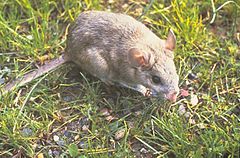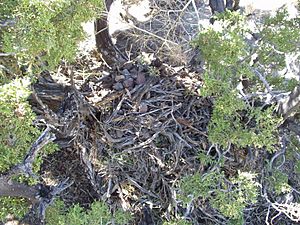Pack rat facts for kids
Quick facts for kids Pack ratsTemporal range: Late Miocene – Recent
|
|
|---|---|
 |
|
| Neotoma cinerea | |
| Scientific classification | |
| Kingdom: | |
| Phylum: | |
| Class: | |
| Order: | |
| Superfamily: | |
| Family: | |
| Subfamily: | |
| Tribe: |
Neotomini
|
| Genus: |
Neotoma
Say & Ord, 1825
|
A pack rat, also known as a woodrat, is a type of rodent. They belong to the group of animals called Neotoma. Pack rats look a bit like regular rats. They have long tails, big ears, and large black eyes. They are bigger than deer mice or harvest mice. Pack rats are usually a bit larger than cotton rats too.
Contents
Where Pack Rats Live
Pack rats are found in many places. They live mostly in the deserts of the western United States. You can also find them in northern Mexico. Some types of pack rats live in forests on the east coast. Others prefer rocky areas in western Canada. They are very good at living in different environments.
Pack Rat Homes
Each type of pack rat usually lives in a specific kind of place. They can live in hot, dry deserts. They also live on cold, rocky mountain slopes. These slopes can be very high up, even above the tree line.
Pack rats build amazing homes called dens. They use twigs, cactus pieces, and other things they find. Their dens have many rooms inside. These rooms are for sleeping and storing food. They also have piles for their trash.
Dens are often built in small caves or rocky cracks. If they live near people, pack rats might move into attics or walls of houses. Some pack rats, like the white-throated woodrat, build homes at the bottom of prickly pear or cholla cactus plants. The cactus spines help protect them from animals that want to eat them.
Other pack rats, like the desert woodrat, build dens around the base of a yucca plant or other cacti. This includes jumping and teddy-bear cholla plants. The largest pack rat, Neotoma cinerea, has a bushy tail. It looks a bit like a squirrel's tail.
Bushy-tailed woodrats live in many different places. These range from cold northern forests to hot deserts. They often live on cliffs and in rocky areas. They need good shelter among the rocks. Sometimes, they even live in old, empty buildings.
Pack Rat Characteristics
Pack Rat Behavior
Pack rats are famous for building nests. They use plant materials like twigs and sticks. They also use any other small items they can find. They especially love shiny objects.
A funny thing about them is how they "trade" items. If a pack rat is carrying something, like a piece of cactus, and sees something it likes better, it will drop what it has and pick up the new item. It's like they're making a trade!
Pack rats can also be quite noisy. They get into many places, like attics and car engines. They might steal small "treasures" and chew on electrical wires. All this can make them a bit of a problem for people.
What Pack Rats Eat
Bushy-tailed woodrats mostly eat green plants. They also eat twigs and shoots. Mexican woodrats have a different diet. They eat seeds, fruits, acorns, and cactus.
Pack Rat Size
Adult male bushy-tailed woodrats usually weigh between 300 and 600 grams. Their average weight is about 405 grams. Adult females are a bit smaller. They usually weigh between 250 and 350 grams, with an average of 270 grams.
Their size can vary a lot. This is because they live in many different climates. Their body size often matches the weather conditions. Males are usually 310 to 470 millimeters long, averaging 379 millimeters. Females are usually 272 to 410 millimeters long, averaging 356 millimeters.
Reproduction and Life Cycle
Pack rats have different ways of reproducing in the wild. Baby pack rats are born without fur and cannot see. They are helpless and need their mothers to care for them. They grow up in special nests called middens.
Some female pack rats can have up to five litters of babies each year. Each litter can have as many as five young. The babies open their eyes when they are about 10 to 12 days old. They usually stop drinking their mother's milk between 14 and 42 days old. Most pack rats can have their own babies after about 60 days.
The number of pack rats in an area can change. This happens about every 8 years. It depends on how many babies are born and how many young ones survive. Female pack rats have different chances of surviving each year. About 42% of young females survive. About 71% of females aged 1-2 years survive. Very few females, less than 5%, live past 3 years old.
Pack Rat Middens

A pack rat midden is a large pile of debris built by a woodrat. These middens are very special. They can keep the materials inside them safe for up to 50,000 years! Scientists can study these old middens. They learn about what the environment was like long ago. By comparing different middens, they can understand how plants and climate changed over time. Studying pack rat middens has become a very important way to learn about past environments. It is often used instead of studying pollen records in areas where middens are found.

If there are no rock cracks or caves, pack rats build their dens under trees or bushes. They use plant pieces, animal droppings, and small rocks to build the den. Most of the building materials come from a short distance around the nest.
Woodrats often pee on their debris piles. The sugar and other things in their urine dry and harden. This creates a material called amberat. Under the right conditions, this amberat can glue the midden together. It can trap plant pieces, pellets, and other debris inside. It's like an amber-like matrix.
Three things help middens last a long time. First, the hardened urine slows down the decay of the materials. Second, the dry climate of the American Southwest also slows decay. Third, middens protected under rock overhangs or in caves last even longer.
See also
 In Spanish: Neotoma para niños
In Spanish: Neotoma para niños

